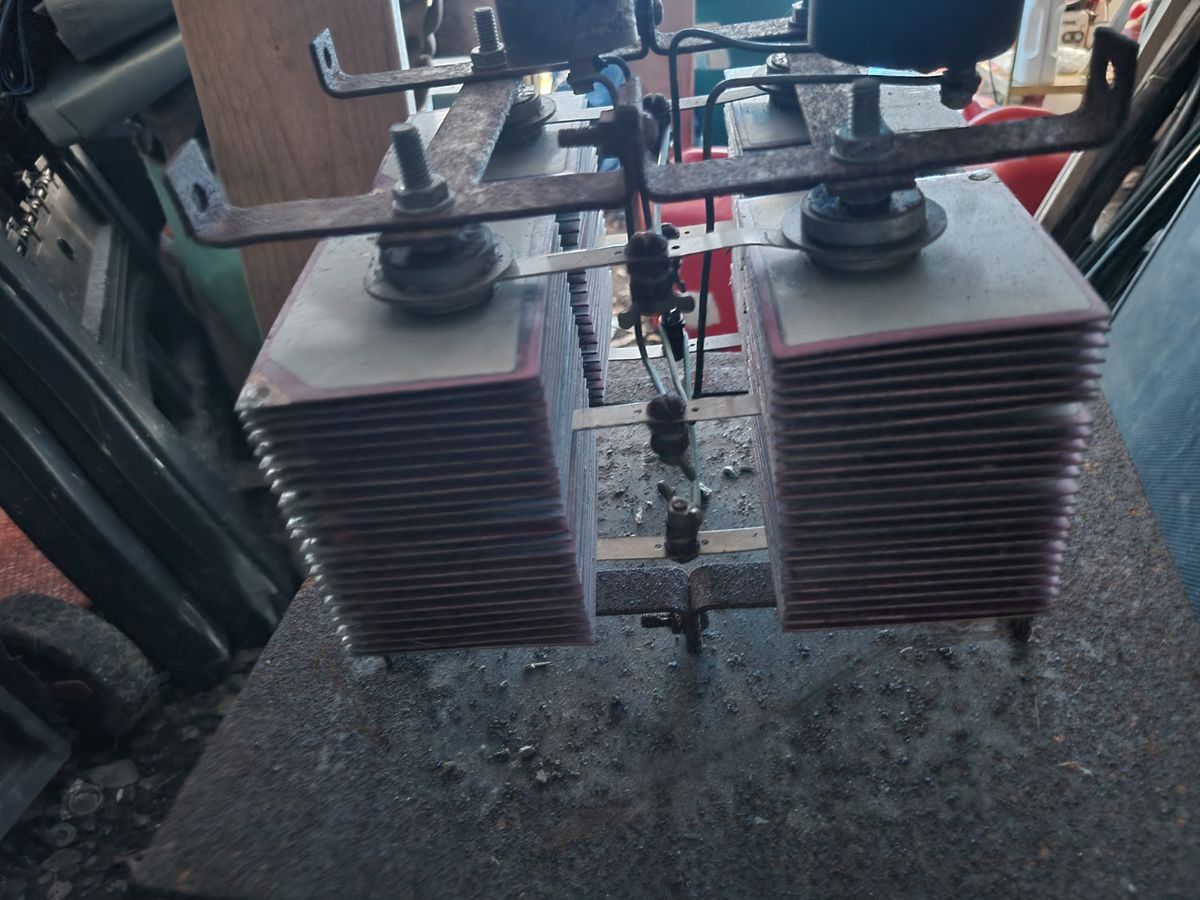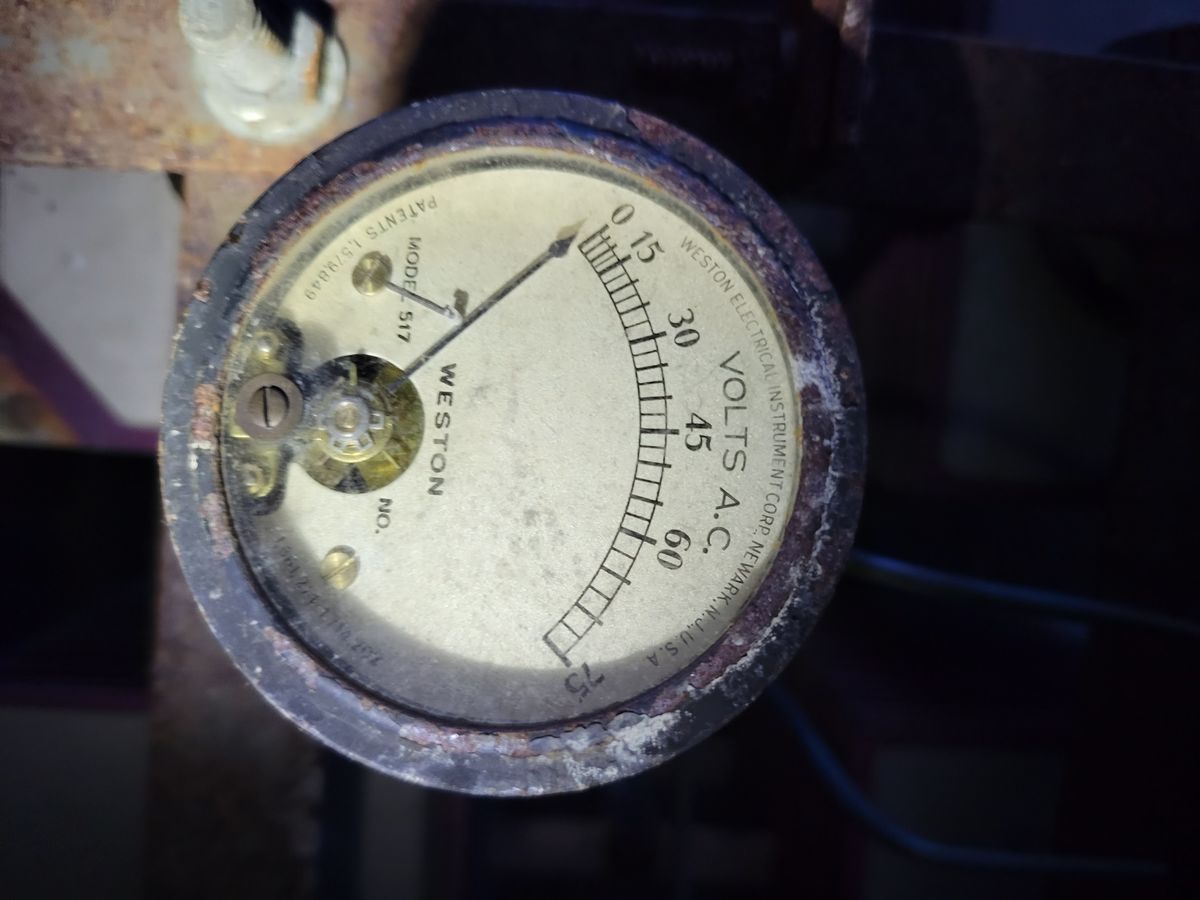Technical Electrical Question
Apr 30, 2022 09:57:18 #
I collect cast iron cookware I clean it using a form of electroless Like reverse electroplating in that I use a 12 volt battery charger to remove rust, paint, and old cooked on grease from antique cast iron pans. The battery chargers don't last very long so I want to make a heavy-duty one and I think this is a old transformer can anyone give any guidance on this I am familiar with 110-220 having wired my home and helped others with theirs, but I am not an engineer. I am interested in positive constructive information thanks.




Apr 30, 2022 10:25:13 #
Apr 30, 2022 10:26:09 #
That's not a transformer, it's a full wave bridge rectifier, which changes AC to DC current, hence the AC and DC current meters. Voltage stays about the same.
Apr 30, 2022 10:32:49 #
A transformer would have coils of wire and probably an iron core. I don’t see that on your picture. What I see looks like two pairs of silicon or selenium rectifiers.
Assuming nothing is shorted out, one pair of those rectifiers would convert your AC current into DC, after it had been through the (unseen and possibly missing) transformer or transformers.
Since there are two pairs of rectifiers and two voltage meters, I suspect this was from a power supply for an old vacuum tube radio which originally used batteries of 2 different voltages; or some low voltage vintage farm electrical system. Perhaps the original power supply was a windmill or a small watermill.
100+ years ago some farms used a 60 volt DC light system, and 60 volt bulbs were plentiful. Photographers discovered that when these 60 bolt bulbs were plugged into the newer 110 volt systems they only lasted an hour or so, but burned at a brilliant intensity. These were the (homebrew) precursor to ‘photoflood’ light bulbs. The market for photoflood lights has nearly vanished but I saw some for sale online a couple years ago.
Since the meters aren’t calibrated past 75 volts, I wouldn’t plug this in to a household electric outlet. The higher voltage is obviously beyond their range and might destroy it.
Right now it is either a vintage electrical relic (and might be worth something to a collector), or dangerous trash.
Why not just use a car battery? Same 12 volts as the car charger you currently use, still DC, can be recharged between uses, and portable.
Assuming nothing is shorted out, one pair of those rectifiers would convert your AC current into DC, after it had been through the (unseen and possibly missing) transformer or transformers.
Since there are two pairs of rectifiers and two voltage meters, I suspect this was from a power supply for an old vacuum tube radio which originally used batteries of 2 different voltages; or some low voltage vintage farm electrical system. Perhaps the original power supply was a windmill or a small watermill.
100+ years ago some farms used a 60 volt DC light system, and 60 volt bulbs were plentiful. Photographers discovered that when these 60 bolt bulbs were plugged into the newer 110 volt systems they only lasted an hour or so, but burned at a brilliant intensity. These were the (homebrew) precursor to ‘photoflood’ light bulbs. The market for photoflood lights has nearly vanished but I saw some for sale online a couple years ago.
Since the meters aren’t calibrated past 75 volts, I wouldn’t plug this in to a household electric outlet. The higher voltage is obviously beyond their range and might destroy it.
Right now it is either a vintage electrical relic (and might be worth something to a collector), or dangerous trash.
Why not just use a car battery? Same 12 volts as the car charger you currently use, still DC, can be recharged between uses, and portable.
Apr 30, 2022 10:35:25 #
The AC voltmeter goes up to 75 volts, so it's definitely NOT on the line side.
Something has to drop the line AC (120v) down. Are you sure there is not something missing? Like an auto-transformer to adjust the AC input?
The output of the bridge is DC, again, is there something to limit the current?
Dangerous to just plug it up to line voltage without some king of voltage reducer, the DC output could be 120v DC.
However doing so may provide an interesting yutube video.......
Something has to drop the line AC (120v) down. Are you sure there is not something missing? Like an auto-transformer to adjust the AC input?
The output of the bridge is DC, again, is there something to limit the current?
Dangerous to just plug it up to line voltage without some king of voltage reducer, the DC output could be 120v DC.
However doing so may provide an interesting yutube video.......

Apr 30, 2022 10:38:45 #
MrPhotog wrote:
A transformer would have coils of wire and probabl... (show quote)
A car battery, without any current limiting circuitry could supply over 600 amps.
There's all kinds of electronics in a good battery charger/eliminator.
Apr 30, 2022 13:26:20 #
Toss that antique (selenium) rectifier stack and instead consider a heavier duty battery charger or DC power supply. Do you have a feel for how much current is required?
Apr 30, 2022 13:34:52 #
TriX wrote:
Toss that antique (selenium) rectifier stack and instead consider a heavier duty battery charger or DC power supply. Do you have a feel for how much current is required?



Apr 30, 2022 14:38:08 #
Yikes!!! As a retired electronics Tech, Yikes... As Longshadow suggested, before you power it up have a video camera guy standing by. Preferably someone with extensive knowledge in emergency medicine.
Apr 30, 2022 15:31:59 #
Retired CPO wrote:
Yikes!!! As a retired electronics Tech, Yikes... As Longshadow suggested, before you power it up have a video camera guy standing by. Preferably someone with extensive knowledge in emergency medicine.

Apr 30, 2022 16:22:47 #
That is an antique Selenium rectifier stack. It is powered by smoke. If you plug it in to the wrong voltage the smoke will leak out and it will no longer work.
PS: Selenium smoke smells stinky.
PS: Selenium smoke smells stinky.
Apr 30, 2022 16:24:24 #
DirtFarmer wrote:
That is an antique Selenium rectifier stack. It is powered by smoke. If you plug it in to the wrong voltage the smoke will leak out and it will no longer work.
PS: Selenium smoke smells stinky.
PS: Selenium smoke smells stinky.



Apr 30, 2022 16:27:08 #
HRPufnstuf wrote:
That's not a transformer, it's a full wave bridge rectifier, which changes AC to DC current, hence the AC and DC current meters. Voltage stays about the same.
Those are volt meters, not current meters.
If they were current meters they would be marked in Amps.
Apr 30, 2022 17:46:54 #
All d’Arsenval meters are current meters. Voltage meters are current meters with a series resistor.
But you’re right that meters designed to measure current directly would be labeled with Amps.
But you’re right that meters designed to measure current directly would be labeled with Amps.
Apr 30, 2022 18:52:47 #
DirtFarmer wrote:
All d’Arsenval meters are current meters. Voltage meters are current meters with a series resistor.
But you’re right that meters designed to measure current directly would be labeled with Amps.
But you’re right that meters designed to measure current directly would be labeled with Amps.
Yes, TECHNICAL DETAILS of operation..............
Still called a volt meter when it measures voltage.

Surprised you didn't how magnetism plays a role...........

(50 years of being an Electronics Engineer, I know how meters work.)
If you want to reply, then register here. Registration is free and your account is created instantly, so you can post right away.



